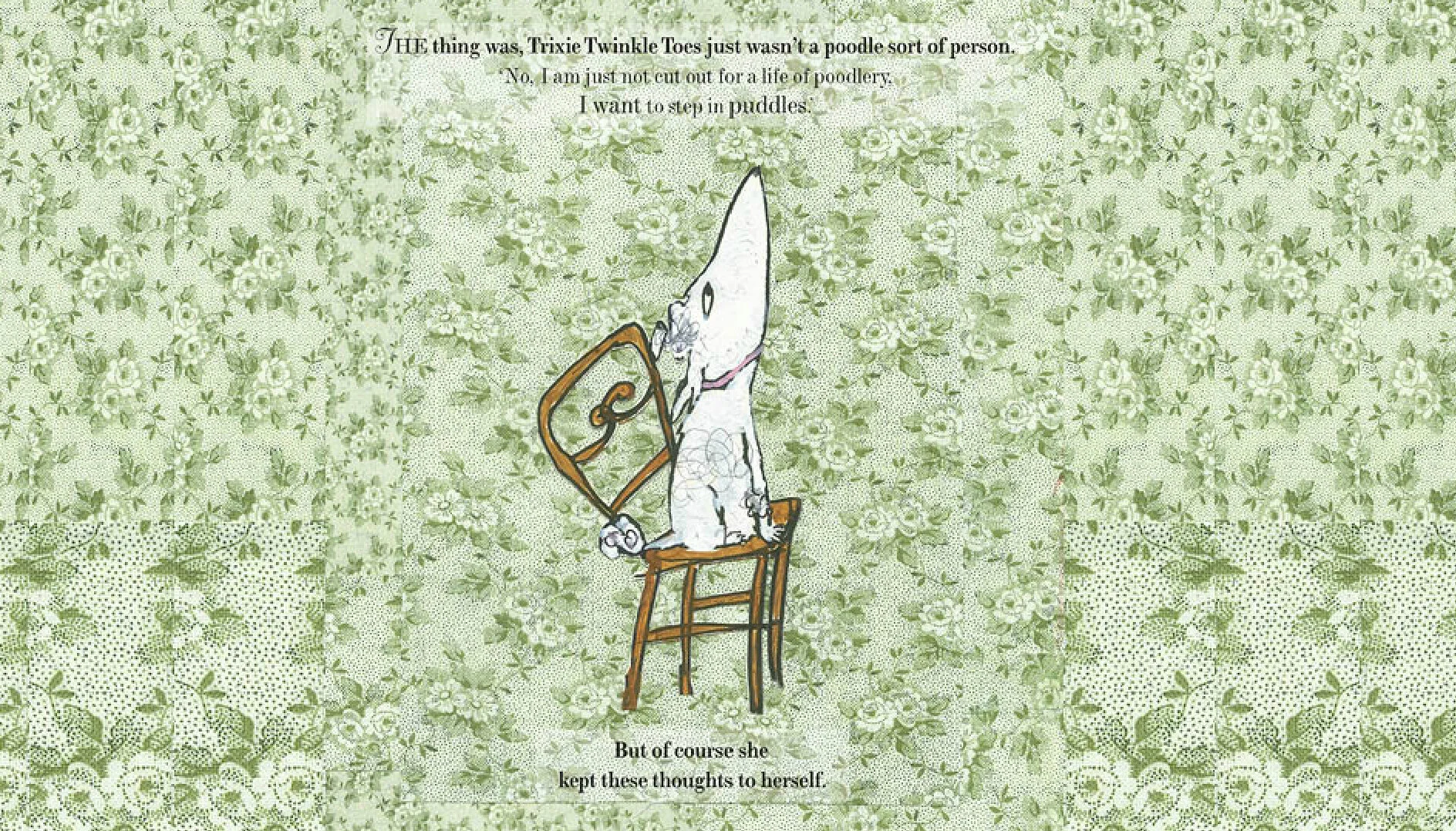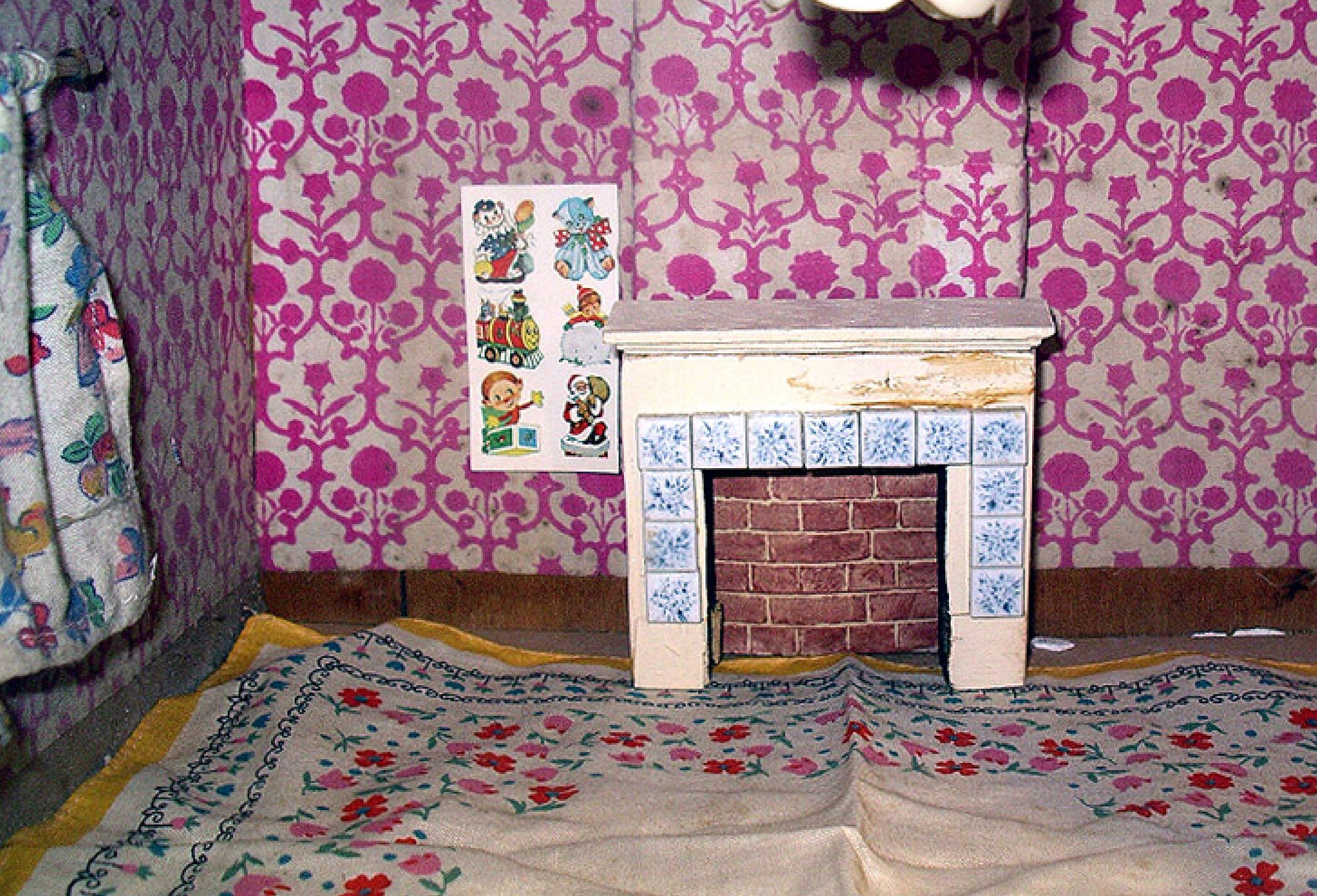Where the Ideas Came From…
Sometime ago, in 2000 or 2001, my friend Verity, a costume designer and shoe enthusiast, bought a cat – she named it Lola. Verity adored Lola and often talked about how she would love to dress her up in a little bonnet and cape – like a Victorian – maybe have her wear little diamond necklaces too. Lola didn't seem like the kind of cat that would put up with this.
Verity and Lola.
Imagining Lola all dressed up made me think about all those little dogs you see carried about in handbags, dressed in tiny canine clothes – some of them in shoes.
Certainly they look funny, often endearing, but they don’t look like dogs – their dogness is somehow taken away from them when the clothes go on.
As a child I had never liked poodles – they always looked a bit stuck up and pleased with themselves, with their bizarre pom-pom hairdos – didn’t they know they looked ridiculous?
Remembering this made me feel bad, because what if they did? What if they did know they looked ridiculous but couldn’t do anything about it? Like when you’re a child and you have to wear something that you hate and you just have to suffer it – like when my parents had my hair cut really short like a boy and I cried – a lot.
The author with a too-short haircut.
The author with a too-short haircut.
I decided to write a story about a poodle who doesn’t really want to live a poodle sort of life – I wrote the whole thing except for the ending – I wasn’t sure what that should be. About eight years later I finally finished it.
Verity never did dress her cat in a bonnet and Lola lives a very cat-like life with Verity’s parents. Verity now has two actual children and as far as I know neither one of them has ever had to wear a bonnet.
Photograph credit: see Puffin Books UK.
The Influence of Film.
This book is greatly influenced by my love of late fifties and early sixties fashion and elegance, which probably came from watching old films when I was a child – films like Charade, Pillow Talk and North By Northwest. All of these I enjoy as much for the costume and set as I do for the plot and the acting.
One of my favourites is Hitchcock’s thriller, Rear Window. It stars Grace Kelly as the beautiful society girlfriend of a hardened photo-journalist played by Jimmy Stewart. Every time she visits his apartment she is wearing an exquisite outfit or breathtaking gown, which he doesn’t seem to notice and yet is impossible for the audience to ignore.
In the setting of Stewart’s slightly Bohemian, and certainly modest apartment, Kelly’s clothes look over-the-top. I think Hitchcock does this for two reasons. One, because he loves glamour and style and two, because, by using this contrast between costume and set he is telling us something about the couple’s differences and the tensions between them: she is all about high society and tradition, while he is trying to escape all that and live a spontaneous, adventurous life. And he tells us this through the images rather than the dialogue.
Book Drawings
In this way, movies and picture books have a lot in common. Just like a film director, it is the illustrator’s job to bring things out of the text and communicate something beyond the words. Of course the pictures are also there to keep the reader entertained just as the filmmaker is also using the clothes and set to create a beautiful visual image, to keep the viewer interested. This is something an illustrator has to think about with each page turn, how to keep the reader entertained and intrigued by the artwork.
Howling
In this picture Trixie is howling miserably because she does not want to live this pampered poodle life. Her room, decorated with bunny wallpaper and bunny drapes, is far more suitable for a child than a dog – I wanted to get across the idea that Trixie’s owner sees her as a person, not an animal. The challenge is for Trixie to make Verity see her as a dog.
I hate being a poooodle.
The Blue room
I always try to think of new ways to show a scene so things don’t become too repetitive, too predictable.
Sometimes I go into a lot of detail so we really know exactly what a particular room looks like. The brightly coloured backgrounds used within the portraits was an idea I got from watching a film called ‘Indiscreet’ with Cary Grant and Ingrid Bergman.
I will become Dangerous and Daring.
Flea Spray
I very often use a simple abstract background because it can give the image more impact. The dog in the cone is such a strong comedy image that I didn’t feel I needed to show much else – I wanted the focus to be on the poodle. I chose this heavy wood texture because it so often appears in 1950’s interior design.
De-flea-ed.
Green roses
This floral background was a way of showing how the little dog is imprisoned by beauty. Here she is sitting on a delicate dining chair in a pretty rose covered room but it is the very last place she feels she belongs.
Wasn’t a poodle sort of person.
The Park
Here I thought it was important to show the poodle in relation to other dogs – the ones she envies. So I set the scene in the park, the place that dogs like best – where they are allowed to get muddy and sniff and chase. The type meanders around the trees, mirroring the freedom of the scampering dogs, in contrast to Trixie who has to walk along this rigid brick path.
That’s what a REAL dog should do.
The trip to the psychic
I had lots of ideas for this scene, some very complicated and detailed. In the end I thought it would work best to conjure the exoticness of Mr Agunadi by using rich patterns and textiles. His words come out of his mouth like steam, adding to the sense of mystery.
Psychic.
Walking in the rain
This is the last but one scene in the book. Finally Verity Brulée has understood that Trixie just wants to be an ordinary everyday dog rather than a pampered accessory.
I thought here it was important to shift the focus and get a dog’s eye view of them out walking in the rain.
Walking in the rain.
Stuck indoors
I think about what I can convey via the picture that I am not saying through the words – the atmosphere in the room. How Verity sits, her style, the view, the elegance.
The pet psychiatrist
There’s no view, no ornament; the psychiatrist is not interested in how things look, but rather what his patient is telling him.
Stuck Indoors/The Pet Psychiatrist.
The Influence of Fashion...
My mother didn’t buy fashion journals but when we went to the hairdressers I got to see copies of Vogue and other style magazines. I liked the way the photographs were taken to conjure up scenes, rather than just display the clothes in an obvious way. The magazines not only pictured the wonderful fashions but also showed you for what occasions you could wear them – a lifestyle you might only dream about could be yours, if only you owned these garments. Drawing and writing are ways of creating a world you might never actually be able to live in, but you can visit in your imagination.
Vogue covers © Vogue.
My mother was very good at sewing and until I was about eleven made dresses for me and my sisters. I remember sitting on the high stools in department stores leafing through the pattern books looking at the designs, I liked the way they were drawn.
Pattern book illustrations from various publishers. © various creators.
From very early on I enjoyed drawing pictures of women dressed in historical gowns or elaborate outfits. Part of my wanting to create this book was so I could draw Verity Brulée's outfits.
I use pattern and textures a great deal in my illustration. When I was a child we had a big drawer of scraps, all left over from clothes my mother had made – my grandmother made quilts from these, I used them to wallpaper my dollshouse.
I was always intrigued to see how a pattern could transform the atmosphere in a room. How you could create grandness or cosiness in exactly the same space, simply by changing the pattern.
This is a dollshouse room I decorated when I was about eight years old. I used an off-cut of fabric from my friend’s scrap drawer – you can see the same fabric in Charlie and Lola’s bathroom in I am Not Sleepy and I Will Not go to Bed.
The dollshouse is rather forlorn looking now, having spent some thirty years in an attic.
I like company when I work – I find it useful to be able to ask people their opinions and I like the buzz of an office. I tend to be more efficient when I go out to work – it makes me more focused, more organised. I was often there at weekends and late into the evening.
Work in progress on Who Wants To Be A Poodle.
My fishbowl office at Puffin, The Strand, London.
Work in progress, Puffin offices, London.
All in all I was in Puffin for about nine months. As well as illustrating Who Wants to be a Poodle, I also did three covers for the Anne of Green Gables series and a cover for Puffin’s 70th anniversary edition of the Secret Garden.
Working on Who Wants to be a Poodle was one of the nicest times I’ve had creating a book – all books feel to some extent like a collaboration, but this one is very much a product of the whole experience of working at Puffin.

























